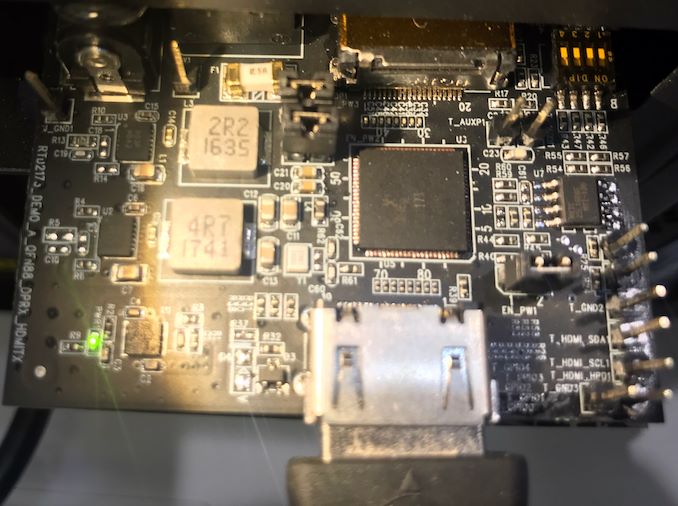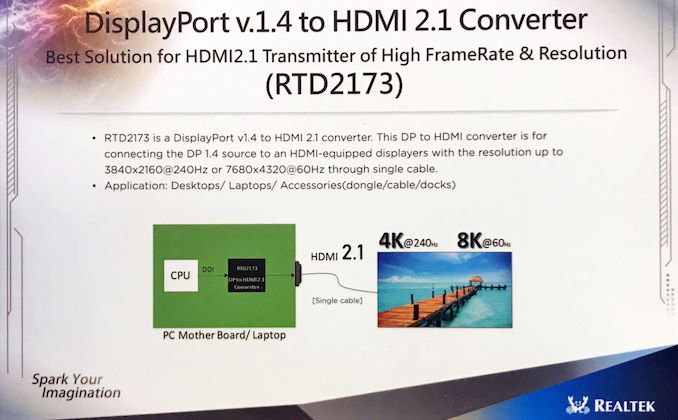Realtek Demonstrates RTD2173 DisplayPort 1.4 to HDMI 2.1 Converter
by Anton Shilov on June 13, 2019 12:00 PM EST- Posted in
- Monitors
- Displays
- HDMI
- Trade Shows
- Realtek
- HDMI 2.1
- Computex 2019

Realtek is working on a chip that will convert DisplayPort 1.4 signals to HDMI 2.1 signals. The RTD2173 converter will enable makers of notebooks, motherboards, docks, and other applications to build devices supporting next-gen HDMI output using current-generation graphics processors that only support DisplayPort 1.4 outputs. Meanwhile, such products will have certain peculiarities.
A number of modern high-end televisions featuring an 8K resolution are outfitted with HDMI ports that are technically ready to receive HDMI 2.1 signals, but are not marketed as HDMI 2.1 because they have not been certified by the HDMI Forum. Once the certification program for HDMI 2.1 is available, producers of Ultra-HD TVs can validate their devices and issue appropriate firmware updates to formally add HDMI 2.1 support. Makers of HDMI cables will release their Ultra High Speed HDMI (48G) cables around the same time.
Meanwhile, at present there are no GPUs that support HDMI 2.1 connection, and even Intel’s 10th Gen Core processors codenamed Ice Lake never mention support for this standard. Therefore, to connect an 8K TV featuring an HDMI 2.1 interface to PCs (or other applications featuring a DP 1.4) special converters or adapters will be needed. This is where Realtek’s RTD2173 chips comes into play.
The RTD2173 chip converts DisplayPort 1.4 signals to HDMI 2.1 signals to enable up to 3840×2160@240 Hz or 7680×4320@60 Hz resolution using a single cable. Keep in mind that the maximum bandwidth supported by a DP1.4 interconnection using the HBR3 data rates is 32.4 Gbps, which is enough for 8Kp60 when Display Stream Compression 1.2 is used. Meanwhile, the maximum bandwidth of HDMI 2.1 is 48 Gbps and it does not need to use DSC 1.2 for 8Kp60.
Realtek’s RTD2173 converter has been implemented in silicon and once it receives certification from the HDMI Forum, it can be used by makers of PCs, dongles, docks, adapters, cables, and other products. Expects devices with HDMI 2.1 output to be available in the coming quarters.
| Want to keep up to date with all of our Computex 2019 Coverage? | ||||||
 Laptops |
 Hardware |
 Chips |
||||
| Follow AnandTech's breaking news here! | ||||||












31 Comments
View All Comments
JasonAT - Thursday, June 13, 2019 - link
Looking further into DSC1.2 specs, I am unsure it actually supports 4:4:4 chroma at high refresh rates. I think it is actually subsampled to 4:2:2 or 4:2:0.Gunbuster - Thursday, June 13, 2019 - link
Or the TV manufacturers could have put on DisplayPort inputs in the first place...weilin - Thursday, June 13, 2019 - link
It's more than just TVs, you'd need receivers and everything else in the home entertainment business to adopt it too.Then the question becomes, why go to DisplayPort, why not go straight to USB-C and support DisplayPort/HDMI alt mode?
stanleyipkiss - Thursday, June 13, 2019 - link
Exactly. USB-C will be better in every single case. Even with power delivery! Why not let my receiver power my bluray player as well?Sancus - Thursday, June 13, 2019 - link
HDMI 2.1 is better than DisplayPort, and it will be a more common standard. LG went the extra mile to add it to their 2019 TVs, and it's the correct step forward.It isn't their fault that Nvidia and AMD don't seem to give a shit.
repoman27 - Thursday, June 13, 2019 - link
I think what you meant to say was LG went the extra mile to add an off-the-shelf HDMI 2.1 scaler to their consumer electronics device, and it isn't AMD or NVIDIA's fault that the HDMI 2.1 spec wasn't released by the time they were done taping out their 10.3B - 18.6B transistor GPUs.timecop1818 - Thursday, June 13, 2019 - link
i like your answers, always so informative wrt DisplayPort, HDMI, thunderbolt, etc.TheUnhandledException - Thursday, June 13, 2019 - link
Yeah that will never happen. The TV oems built HDMI to have a spec THEY control. Displayport is cheaper to implement and without licensing. Have you ever seen a single HDTV with a single displayport input? Just one would be nice for connecting a computer and the rest HDMI but even that? Nope. HDMI or bust.jeremyshaw - Friday, June 14, 2019 - link
At least one in Japan and, of course, the rather expensive HP Emperor (with Nvidia G-Sync, probably the only reason why it even has DP input). I guess the new ASUS version of the Nvidia BFGD will have a DP, too.TheUnhandledException - Thursday, June 13, 2019 - link
" Keep in mind that the maximum bandwidth supported by a DP1.4 interconnection using the HBR3 data rates is 32.4 Gbps, which is enough for 8Kp60 when Display Stream Compression 1.2 is used. Meanwhile, the maximum bandwidth of HDMI 2.1 is 48 Gbps and it does not need to use DSC 1.2 for 8Kp60."That is not correct. 8K60 with CVT-R2 blanking requires 62.06 Gbps at 10 bit color (49.65 Gbps @ 8 bpc) for 4:4:4 or RGB. So even with the higher bitrate of HDMI 2.1 it requires DSC.
Now 4K120 (10 bit) requires 32.27 Gbps so it can be done by HDMI 2.1 without DSC but would require DSC if using displayport 1.4. Since LG OLED support 120 Hz input the question is do they support it with DSC?